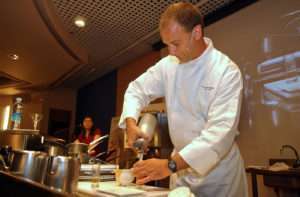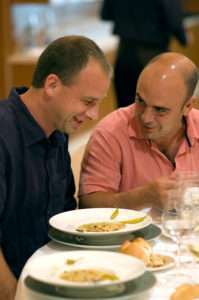An American chef brings a taste of the South to Spain
By Sofia Perez
[Published in the James Beard Foundation’s Beard Bites, November 2007]

Chef John Fleer demoing one of his dishes at the conference (Photo by Montxo A.G.)
“I’d like to end my presentation with the most important product that has ever come from the state of Tennessee,” said chef John Fleer, addressing the audience at a gastronomy conference in Pamplona, Spain. He cued the A/V technician and suddenly the screen behind him filled with a larger-than-life image of Elvis in all his pompadoured splendor, as the crowd laughed appreciatively. Fleer, then the chef of Blackberry Farm, the critically acclaimed Relais & Châteaux property in the foothills of the Great Smoky Mountains, went on to demonstrate his interpretation of one of the King’s favorite culinary fixes: the fried peanut butter and banana sandwich. To make his version, dubbed “Velvet Elvis,” Fleer deep-fried a panko-coated peanut butter and banana sandwich and served it alongside a Martini glass filled with layers of crumbled, freshly baked vanilla wafers, peanut butter custard (slightly hardened after a quick freeze with liquid nitrogen), and warm banana foam. He sprinkled the foam with a caramel-colored powder, produced by combining peanut butter and tapioca maltodextrin. We were a long way from Graceland.
In the summer of 2006, Fleer made the trip from Walland, Tennessee, to the gastronomy conference in Navarra, Spain, to serve as an unofficial ambassador for Southern food. Held in the city best known for the annual running of the bulls, this iteration of Pamplona’s conference was the fourth annual gathering organized by the region’s leading chef, Koldo Rodero of the Michelin-starred Restaurante Rodero in Pamplona. With the goal of helping to establish the city as a cauldron of international gastronomic debate, Rodero expanded the year’s lineup to include several representatives who hailed from beyond Spain’s borders. In addition to Iberian luminaries, such as Jordi and Josep Roca of Catalonia’s El Celler de Can Roca, Andoni Luis Aduriz of Mugaritz in the Basque Country, and Marcelo Tejedor of Galicia’s Casa Marcelo, the roster featured Emanuele Scarello of Agli Amici in Italy’s Friuli region, Jean Chauvel of Les Magnolias, just outside Paris, and Fleer, the sole non-European toque in attendance.
Although many of the folks who paid for the chance to see these chefs in action came from the worlds of gastronomy and tourism, the event was also open to the food-obsessed layperson, a fact that added another dynamic to Fleer’s presentation. Though most leading Spanish chefs have traveled to the United States at one point or another, the average Spaniard still believes that the American menu is comprised mainly of hamburgers, hot dogs, and other chain-restaurant staples. The burgeoning dining scene that has developed in the U.S. over the last 20 years, with its emphasis on local, seasonal produce, remains largely unknown to most Spaniards. It was no accident that Fleer chose to pay homage to one of the King’s fetishes as well as present an haute version of another dubious American classic, a salad of iceberg lettuce, cottage cheese, and canned peaches. Fleer’s spin on this last dish was an amuse-bouche—a shot glass filled with layers of iceberg gelée, peach purée, and a cottage cheese foam, seasoned with Maldon salt and smoked paprika oil. In addition to displaying the gentle humor that runs through much of his work, these dishes offered a way for Fleer to play with the audience’s preconceived notions. “This type of food is such a huge part of Americana,” he said. “You’ve got to acknowledge it.”
Still, Fleer’s overriding goal was to give the crowd a taste of his “Foothills Cuisine,” the term he used at Blackberry Farm to denote his regional cooking’s origins in Appalachia and in the South. “In the U.S.,” he said, “I don’t think there are many places where there is a true regional cuisine, but in the South we’re very lucky to have a long history of it.” Drawing on his background as an aspiring professor—a Duke graduate, he was pursuing his masters at the University of North Carolina when he began cooking at a local eatery and decided to detour into the restaurant world—Fleer gave the Pamplona audience a brief history of Southern food. He touched on the varied influences of European, Native American, African, and Caribbean cultures, with respect to both the larder and techniques that are employed in the region’s kitchens.
Fleer also explained his self-defined concept of Foothills Cuisine, a combination of high and low elements, both rustic and refined at once. “I don’t want to do purely traditional cuisine,” he said. “I want what I do to be exciting and to treat ingredients differently, using old techniques in new ways and bringing new techniques to bear on classic ingredients.” He said he saw this as a way for American chefs to encourage the wider public to embrace the world of haute cuisine, a realm that can seem alien or intimidating to some.
To illustrate the blend of traditional and modern elements in his food, Fleer also prepared a kind of mille-feuille, with layers of foie gras flan, sorghum crisps, corn custard, and sweet tea gelée (the last component being his nod to the “wine” of the South), as well as a second dish of pork tenderloin crusted with black-eyed pea powder that he served with barbecue pork confit, boiled peanut froth, red pepper grits, and potlikker essence (the liquid that remains from cooking collard greens in pork fat). The recipes captured the imagination of the audience. “I think it’s interesting that he’s using products that we also have here in Spain, but that are not valued by Spaniards, such as corn,” said Ana Irurita Arenal of Navarra’s hotel association. “Also, it’s very unusual to use the black-eyed pea powder as a kind of breading. We have all sorts of bean varieties in this area, but you don’t see them applied in this way. A presentation like this opens up all sorts of doors and demonstrates intriguing possibilities.”

Chefs John Fleer and Koldo Rodero
Although his dishes may have been intriguing, it’s unlikely that all of the elements Fleer presented will become widely adopted in Spain. Several of the Southern ingredients that he brought with him have thus far been rejected by the Spanish palate. Some audience members cited the heavy use of peanuts as a turnoff, and Rodero pointed to another ingredient not readily accepted in Spain: catfish. “It surprised me to hear that people eat a lot of catfish [in the Southern U.S.],” he said, “because even though we have that fish here as well, many think it’s disgusting and won’t touch it.” Despite these differences, Fleer sees several connections between Appalachia and Navarra (and the adjacent Basque Country). Both regions feature lush mountain landscapes and more than a few closed mountain communities that have sprung out of the historic isolation imposed by the terrain; a fierce spirit of independence and a resistance to being absorbed into the larger country that surrounds them; and shared staples such as trout, beans, and especially pork.
For Silvia Azpilicueta, Pamplona’s director of tourism, the comparisons extended to the current restaurant scene: “The ideas of adding in a sweet component to the pork dish, of using the same ingredient to express different textures, or of employing custards and flans in savory dishes—all of these things are very similar to what we are seeing here.”
Conference attendees also appreciated that Fleer offered a clear sense of the origins of his food. “I liked that his presentation was based on local products,” said Philippe Regol, a self-styled “gastronomic observer” and the conference’s co-organizer. “Fleer does just enough to the ingredients to achieve his goals, without overly relying on strange and unnecessary techniques. I went into it hoping to see something different from what we know here and that’s exactly what he gave us.”
Rodero concurred. “You can tell that his is a cuisine with roots. He expresses the terroir of his region, and he does so with robust and strong flavors, but also with a certain delicacy. It’s clear that John has tablas,” he said, using the colloquial Spanish phrase that means Fleer is a true professional.
In describing the presentation, another chef praised Fleer at the expense of some of his U.S. colleagues. “I was at Madrid Fusión this year,” said Alejandro Guzmán, a consulting chef and a partner in Barcelona’s Manairó restaurant, referring to the 2006 technology-driven gastronomy conference, which featured several leading American chefs. “It seemed to me that the Americans in Madrid were all trying to be El Bulli, made in America,” Guzmán said. “They’ve hopped on that train and they’re following the things that have been done here, but without adding something that’s uniquely theirs. What I liked about John is that he isn’t embarrassed to use humble ingredients in his dishes, like peanut butter, corn, and pork, and he carries it all off with a great deal of dignity, employing intelligent technique to make simple products better.” Specifically, Guzmán cited a pickled watermelon rind that Fleer used as an acidic counterpoint to the richness of foie gras. (During his presentation, Fleer noted that the watermelon recipe was his grandmother’s.) Guzmán added, “Although I don’t necessarily agree with the overuse of certain ingredients, I recognize that these are products that are well-liked by people there, and after all he’s creating food for that audience, not for us.”
Knowing your roots and expressing them is something that has always been of the utmost importance to Fleer, and it’s one of the reasons that he’s long been fascinated by Spain. In 2003, he traveled around the country for five weeks with his wife and three sons, spending a good chunk of time in Barcelona, but also visiting Madrid, Sevilla, and Andalucía’s Sierra Nevada. One of the things that stood out for him, culinarily, was the strong sense of regional pride that exists all over Spain. “There is this kind of balance between regionalism and creativity or inventiveness, and it’s a source of inspiration for me,” he said, adding that the place in the United States where he thinks that this is most likely to be emulated is in the South.
Nowhere was this balance better illustrated than in the content of the conference itself. The presentations ran the gamut from Jordi Roca, El Celler de Can Roca’s pastry chef, discussing his collaboration with a perfume designer to help create a dessert based on famous fragrances, and Aduriz explaining how he makes his flourless “gnocchi” by combining kudzu starch with the liquid that results from cooking Idiazábal cheese in a broth, to Nacho Manzano, chef of Casa Marcial in Asturias, Spain, defining his cuisine as an homage to his mother and his rural homeland in northwest Spain.
In addition to presenting a range of styles and philosophies, Rodero, a Pamplona native, also wanted the gathering to provide Fleer and the other visiting chefs with a sense of Navarra’s rich culinary past and present through a series of meals and outings. These included a dinner at Quaderna Vía, an organic winery near the small city of Estella, featuring organically raised local ingredients such as artichokes, asparagus, peppers, beans, and lamb, as well as a lunch at Napardi, a traditional all-male Basque gastronomic club right in the heart of Pamplona. In between courses during this last meal, several club members serenaded their visitors with a cappella renditions of old classics. The songs were mostly about food and alcohol, including one ditty about the desire to be buried in a tunnel full of wine in order to drink your way out. The soused song lyrics notwithstanding, it’s this interplay between old and new that continues to attract Fleer to Spain. “There’s such total positive tension between the traditional food and the most cutting-edge food in the world,” he said. “And people are passionate about both.”
These are passions that Fleer doesn’t think are fully expressed yet in the United States, and that he’d like to see take greater hold. “We’re a big country, but we’re still trying to cover a lot of ground,” he explained. Ultimately, Fleer believes that each chef needs to find his or her own inspiration in the very ground itself. Before leaving Blackberry Farm last February, he had spent 14 years there cooking in the foothills of Tennessee. He continues to be based in the southeastern United States, where he is working as a consultant to various restaurants in the region, and he hopes to open his own place there in the future. Though the specific details of that restaurant are yet to be determined, there is one aspect of his plans that is certain. “For me being a chef is about expressing a place,” he said, adding, “If nothing else, cuisine has to have heart, and the Southeast is where my heart is.” Elvis couldn’t have said it better himself.



